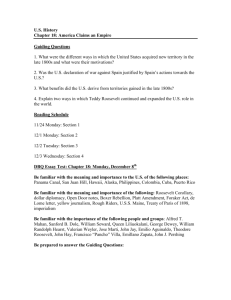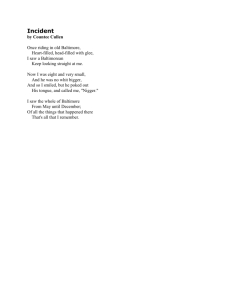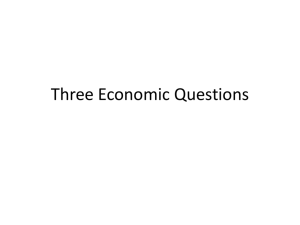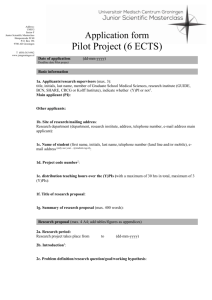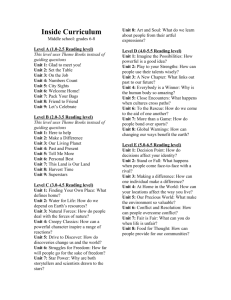The Role of Statistical Science in Guiding Health Policy
advertisement
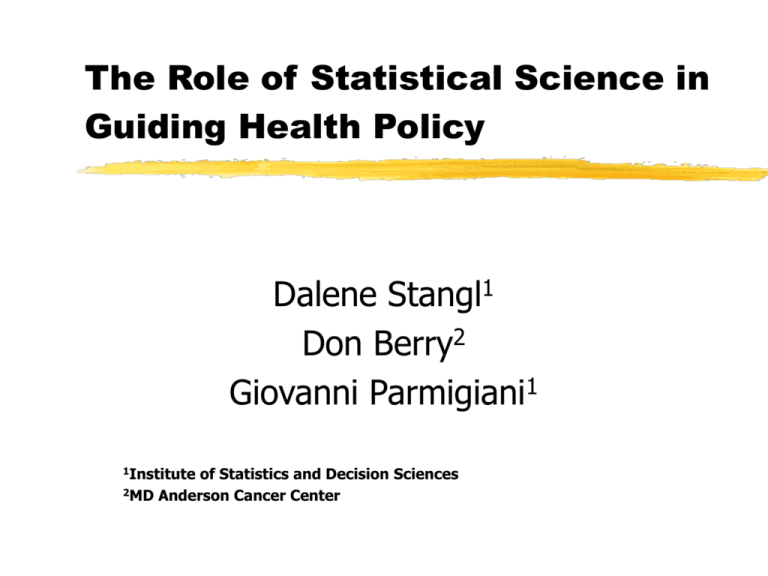
The Role of Statistical Science in Guiding Health Policy Dalene Stangl1 Don Berry2 Giovanni Parmigiani1 1Institute of Statistics and Decision Sciences 2MD Anderson Cancer Center The Role of the Statistician in Policy Analysis and Research Sir Claus Moser’s, 1975 ASA meeting, the “foremost responsibility (of the statistician) is to contribute to more enlightened and efficient ‘decision making’ … through the fullest possible exploitation of our skills in analyzing and interpreting the data.” Dorothy Price, Director, National Center for Health Statistics, (1976), The American Statistician, “The Role of Statistics in the Development of Health Care Policy” “…. As in other areas of social policy, health statisticians and health data are increasingly expected to provide keys to rational decision making. To accomplish this goal, the statistician and decision maker need to interact to an increasing degree.” John Tukey, 1976, Am. J. of Epidemiology “…those statisticians for whom opportunity and a natural bent combine to offer experience and the development of expertise ought, in the public interest, become as much policy makers as their roles allow.” The Role of Statistical Science in Guiding Health Policy, JSM, Monday August 9, 1999, Baltimore, Md. Quote Commonalities All refer to importance of decision-making Recommend more involvement of statisticians All statements were made 20-25 years ago The Role of Statistical Science in Guiding Health Policy, JSM, Monday August 9, 1999, Baltimore, Md. Focus of past 25 years 1970s and 1980s Develop coordinated, systematic data base “At NCHS we are searching for innovations to enhance data production with minimal increased demand on resources and to provide data in a timely fashion…. We are being asked to produce more data, which is more relevant, with resources that are not growing commensurately. We are being asked to aid in the interpretation and analysis of the data as well.” 1990’s Statistics and Policy (B.D. Spencer ed., 1997) no mention of decision theory “The statistical basis of public policy: a paradigm shift is overdue” (Lilford and Braunholtz, 1996) Bayesian methods superior to conventional methods. Primary advantages Utility functions were given sentence + reference The Role ofone Statistical Science in Guiding Health Policy, JSM, Monday August 9, 1999, Baltimore, Md. ‘Typical’ Bayesian Solution Hospital Profiling Outcome ex. - mortality rate at time t (adjust case-mix) Classical - Z-scores Bayesian - Posterior probabilities of ‘excess’ mortality Implicit rather than explicit decision analysis How is decision-making embedded in the analysis? choice of outcome time point relative performance measure versus national guideline of performance quality thresholds posterior tail areas Sufficient? The Role of Statistical Science in Guiding Health Policy, JSM, Monday August 9, 1999, Baltimore, Md. Why Insufficient? Needs explicit decision-theoretic framework Two proposals relinquish automatic constant utilities embedded in p-values and posterior probabilities present statistical output in ways that increase the possibility and probability of applying a wide diversity of utility functions The Role of Statistical Science in Guiding Health Policy, JSM, Monday August 9, 1999, Baltimore, Md. Prescriptive Perspective “Making Health Policy Decisions: Is Human Instinct Rational? Is Rational Choice Human.” Paltiel and Stinnett, Chance, 1996 Approach formal analysis from a prescriptive perspective, I.e. aim to provide decision-makers with information that can help them to make better choices but stop short of telling them what to do. “By being forced to consider this issue explicitly, people may, whatever their final decision, benefit from scrutinizing and coming to grips with values to which they had previously given little thought.” The Role of Statistical Science in Guiding Health Policy, JSM, Monday August 9, 1999, Baltimore, Md. Proposal 1: relinquish automatic constant utilities embedded in p-values and posterior probabilities i threshold, D two decisions d0 accept - sufficient quality d1 reject The Role of Statistical Science in Guiding Health Policy, JSM, Monday August 9, 1999, Baltimore, Md. d1 is better than d0 if >D d0 is better than d1 if >D U(d,) measures the worth/utility of d when the uncertain value is Figure 1. i sufficient Dnot sufficient The Role of Statistical Science in Guiding Health Policy, JSM, Monday August 9, 1999, Baltimore, Md. Constant and Linear Utility Figure 2. Constant Utility Function U(d0,) U(d1,) D sufficient Figure 3. Linear Utility Function U(d0,) i U(d1,) i D not sufficient sufficient The Role of Statistical Science in Guiding Health Policy, JSM, Monday August 9, 1999, Baltimore, Md. not sufficient Compromise Utility Figure 4. Compromise Utility Function U(d0,) U(d1,) i D sufficient not sufficient The Role of Statistical Science in Guiding Health Policy, JSM, Monday August 9, 1999, Baltimore, Md. Loss of declaring sufficiency Figure 7. Loss of Declaring Sufficiency L()=U(d1,)-U(d0,) i D sufficient not sufficient The Role of Statistical Science in Guiding Health Policy, JSM, Monday August 9, 1999, Baltimore, Md. Uncertainty in Calculate expected loss L()p() Declare sufficient quality iff negative Balances cost/benefits in a simple, comprehensive way The Role of Statistical Science in Guiding Health Policy, JSM, Monday August 9, 1999, Baltimore, Md. Specifying Loss Not the statistician’s loss function Statistician can help decision-maker articulate value judgements in a way that allows coherent procedure Figure 7. Loss of Declaring Sufficiency L()=U(d1,)-U(d0,) i D The Role of Statistical Science in sufficient not Guiding Health Policy, JSM, Monday August 9, 1999, Baltimore, Md. sufficient Extensions other loss functions multivariate outcomes - Tan and Smith (1998) prior elicitation The Role of Statistical Science in Guiding Health Policy, JSM, Monday August 9, 1999, Baltimore, Md. Proposal 2: Predictive Distributions for General Outcomes Hospital Profiling excessive mortality at time t as measured by 1.5 x median mortality across all hospitals predictive survival curves across time Advantages allow diversity of utility functions metric upon which values are easily understood incorporate QUALYs Disadvantages requires event times harder to model The event times than dichotomous Role of Statistical Science in outcomes Guiding Health Policy, JSM, Monday August 9, 1999, Baltimore, Md. Other Thoughts Meta-Analysis in Medicine and Health Policy (Stoto) Attitudes of Policy World Graduate Education Attitudes of Statisticians The Role of Statistical Science in Guiding Health Policy, JSM, Monday August 9, 1999, Baltimore, Md. References Berger, J.O. and Delampady, M. (1987). Testing precise hypotheses (with discussion). Statistical Science 2: 317-352. Berger, J.O. and Sellke, T. (1987). Testing a point-null hypothesis: the irreconcilability of p-values and evidence ( with discussion). J. Amer. Statistica Assoc. 82:112-139. Berger. R.L. and Hsu, J.C. (1996). Bioequivalence trials, intersection-union tests and equivalence confidence sets (with discussion). Statist. Sci. 11:283-319. Bernardo, J.M. and Smith, A.F.M. (1994). Bayesian Theory. Wiley. Chichester. Casella, G. and Berger, R.L. (1987). Reconciling Bayesian and frequentist evidence in the one-sided testing problem. J. Amer. Statist. Assoc. 82: 106-111. Cochran, W.G. (1976). The role of statistics in national health policy decisions. American Journal of Epidemiology 104(4):370-379. Lilford, R.J. and Thornton J.D. (1992). Decision logic in medical practice. Journal of the Royal Collegeof Physicians of London, 26(4):400-412. Lilford, R.J. and Braudholtz, D. (1996). The statistical basis of public policy: a paradigm shift is overdue. British Medical Journal 313(7057):603-607. Lindley, D.V. (1985) Making Decisions. Wiley, Chichester. Lindley, D.V. (1997) The choice of sample size (with discussion). The Statistician 46: 129-166. Lindley, D.V. (1998) Decision Analysis and Bioequivalence Trials. Statistical Science 13(2): 136-141. Lindley, D.V. and Singpurwalla, N.D. (1991). On the evidence needed to reach agreed action between adversaries, with application to acceptance The Rolesampling. of Statistical J. Amer. Science Statist. in Assoc. 86: 933-937. Guiding Health Policy, JSM, Monday August 9, 1999, Baltimore, Md. References continued... Normand, S., Glickman, M., Gatsonis, C. (1997). Statistical methods for profiling providers of medical care: issues and applications. J. Amer. Statist. Assoc. 92(439):803-814. Paltiel, A.D. and Stinnett A.A. (1996). Making health policy decisions: Is human instinct rational? Is rational choice human? Chance 9(2):34-39. Rice, D. (1977). The role of statistics in the development of health care policy. The American Statistician 31(3):101-106. Tan S.B. and Smith, A.F.M. (1998). Exploratory thoughts on clinical trials with utilities. Statistics in Medicine 17:2771-2791. Tukey, J.W. (1976). Discussion of: “Role of statistics in national health policy decisions.” American Journal of Epidemiology 104(4):380-385. The Role of Statistical Science in Guiding Health Policy, JSM, Monday August 9, 1999, Baltimore, Md.
